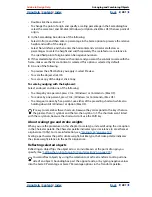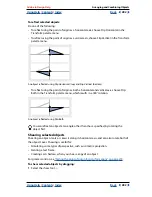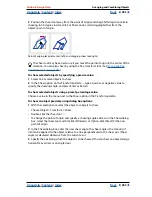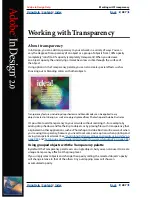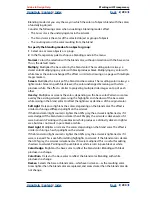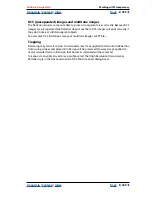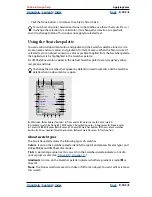
Using Help
|
Contents
|
Index
Back
294
Adobe InDesign Help
Working with Transparency
Using Help
|
Contents
|
Index
Back
294
Rounded
The corners are rounded by the feather radius; in effect, the shape is first inset,
then outset, to form the two contours. Rounded creates a pleasing effect on rectangles.
Diffused
Uses the Adobe Illustrator method, which makes the edges of the object fade
from opaque to transparent.
6
Select Preview to display the results on-screen.
7
Click OK.
About flattening
Flattening cuts apart transparent art to represent overlapping areas as discrete pieces that
are either vector objects or rasterized areas. As artwork becomes more complex (mixing
images, vectors, type, spot colors, overprinting, and so on), so does the flattening and
its results.
Flattening occurs whenever you print from InDesign or export to a format other than
Adobe PDF 1.4 (Acrobat 5.0). InDesign flattens transparent objects according to the
settings in the selected flattener style. (See
“Controlling flattener settings and results using
styles” on page 294
.)
Flattening cuts transparent art apart to represent overlapping areas as discrete pieces that
are either vector objects or rasterized areas; this example involves only vector objects
Controlling flattener settings and results using styles
If you regularly export or print documents that contain transparency, you can automate
the flattening process by saving flattener settings in a flattener style.
To apply a flattener style to a document or book:
In the Advanced panel of the Print or Export dialog box, choose a transparency flattener
style in the Style menu.
Note:
To use custom flattener styles, see
“Creating, saving, and loading custom flattener
styles” on page 295
.
About predefined flattener styles
For your convenience, InDesign includes three predefined transparency flattener styles.
The settings are designed to match the quality and speed of the flattening with the
resolution of rasterized transparent areas, depending on intended use.
Low Resolution
Use for quick proofs that will be printed on black-and-white desktop
printers, and for documents that will be published on the Web or exported to SVG.
Medium Resolution
Use for desktop proofs and print-on-demand documents that will
be printed on PostScript color printers.


